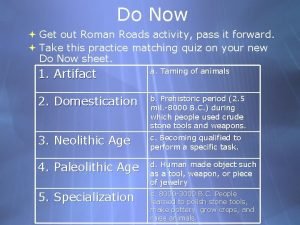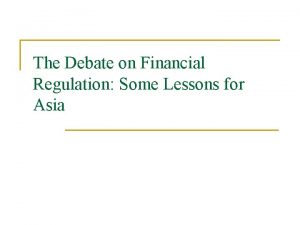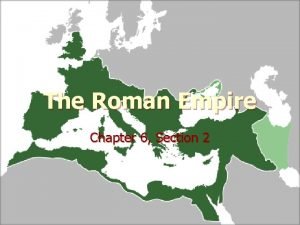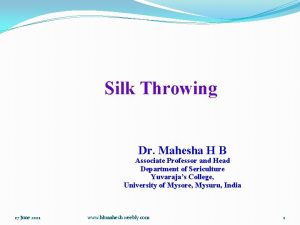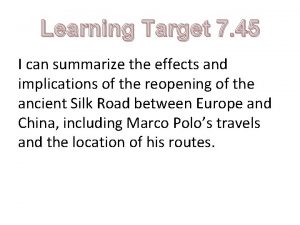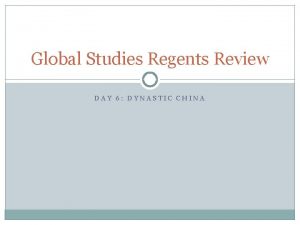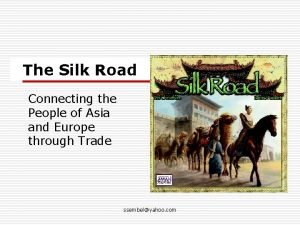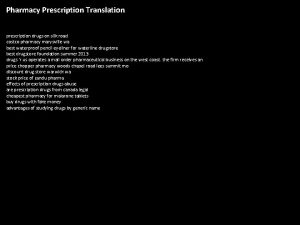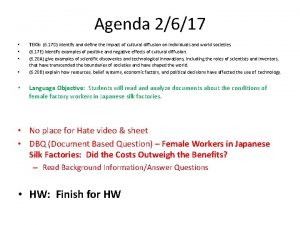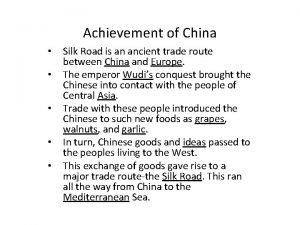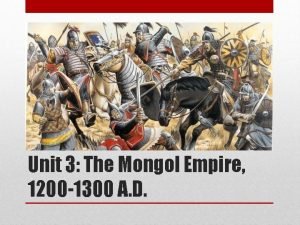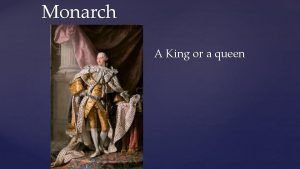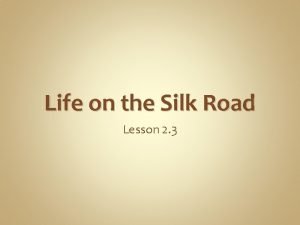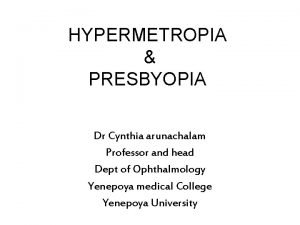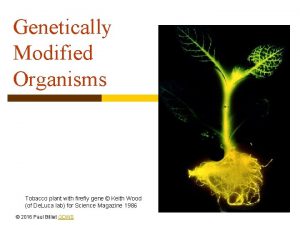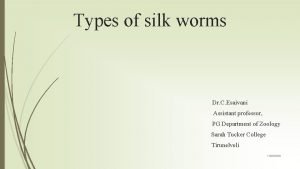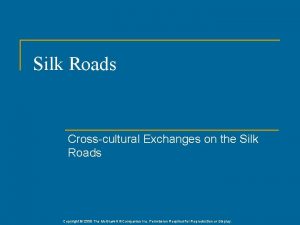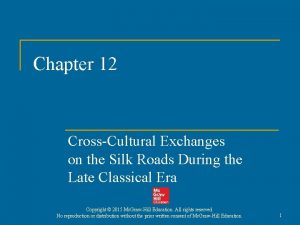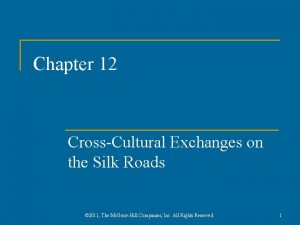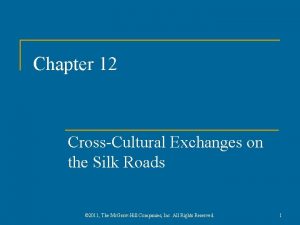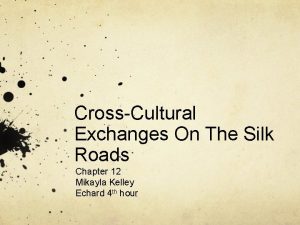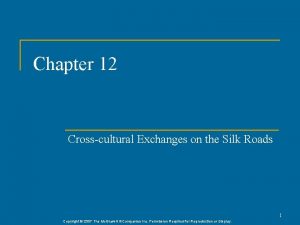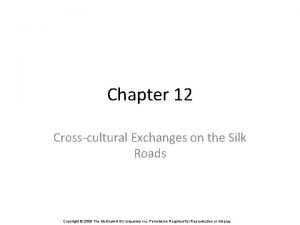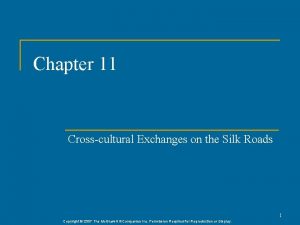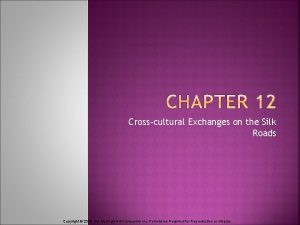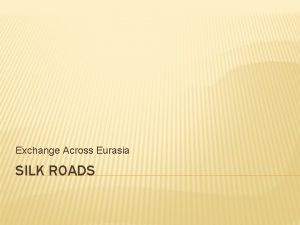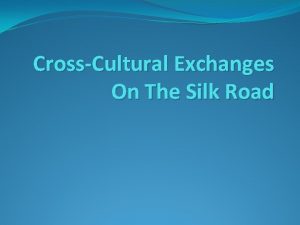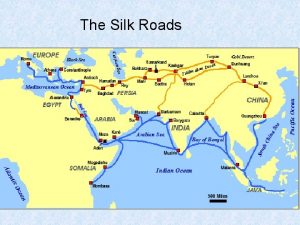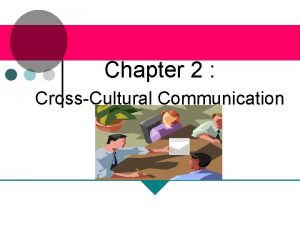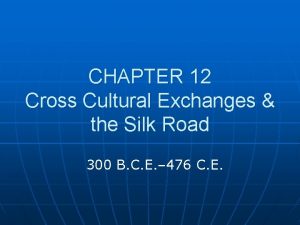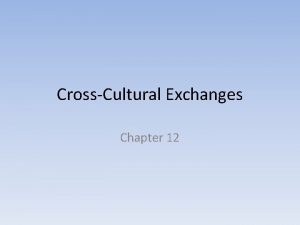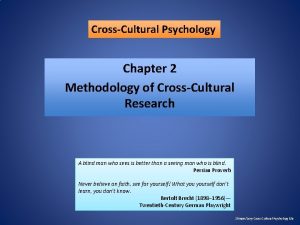Chapter 12 CROSSCULTURAL EXCHANGES ON THE SILK ROADS



























- Slides: 27

Chapter 12 CROSS-CULTURAL EXCHANGES ON THE SILK ROADS DURING THE LATE CLASSICAL ERA 1

2

Long-Distance Trade and the Silk Roads Network Increase and development of networks for 2 reasons ◦ Improvement of infrastructure ◦ Governments spent considerable amount of money and resources to create roads to connect large empires ◦ This investment encouraged trade within large empires as well with other large empires farther away ◦ Development of empires ◦ Most large empires bordered other large empires ◦ Hellenistic-Indian ◦ Greek Colonization ◦ Persia - Indian 3

Hellenistic Trade Networks Dramatic increase in trade due to Greek colonization Maintenance of roads, bridges Discovery of monsoon wind patterns- key to sea trade Increased tariff revenues used to maintain open routes Bactria and India ◦ Spices, pepper, cosmetics, gems, pearls Persia and Egypt ◦ Grain Mediterranean region ◦ Wine, olive oil, jewelry, art Development of professional merchant class 4

5

The Silk Roads Named for principal commodity from China Dependent on imperial stability in each empire Overland trade routes from China to Roman empire Sea lanes and maritime trade as well From Chang’an in the Han Dynasty to Antioch ◦ Taklamakan desert was dangerous to travel Sea trade ◦ Malay and Indian mariners ◦ Persian, Egyptian, Greek 6

COPYRIGHT © 2015 MCGRAW-HILL EDUCATION. ALL RIGHTS RESERVED. NO REPRODUCTION OR DISTRIBUTION WITHOUT THE PRIOR WRITTEN CONSENT OF MCGRAW-HILL EDUCATION. 7

8

Spread of Buddhism and Hinduism Merchants carried religious ideas and disease along Silk Roads India through central Asia to east Asia Cosmopolitan centers promoted development of monasteries to shelter traveling merchants which converted them to Buddhism became dominant faith of Silk Roads, about 100 B. C. E. – 800 C. E. Sea routes allowed for Buddhism and Hinduism to spread to Southeast Asia Rulers of South Asian states called themselves rajas (Indian word for king) and adapted Sanskrit 9

The Spread of Buddhism, Hinduism, and Christianity, 200 B. C. E. – 400 C. E. 10

Christianity in the Mediterranean Basin Persecution was common from Roman Emperors because Christians would not accept Roman deities (Similar to Jews) Gregory the Wonderworker, central Anatolia, third century C. E. ◦ Expelled demons, moved boulders, diverted a river Christianity spread through Middle East, north Africa, Europe Sizeable communities as far east as India 11

Christianity in Southwest Asia Along with Jews and Zoroastrians Influence of ascetic practices from India (Jainism) Desert-dwelling hermits, monastic societies After fifth century C. E. , followed Nestorius (Nestorians) ◦ Emphasized human nature of Jesus ◦ Spread along Silk Road 12

13

The Spread of Manichaeism Mani (216– 272 C. E. ), devout Zoroastrian from Babylon Viewed himself prophet for all humanity Influenced by Christianity and Buddhism ◦ Zarathustra prophet of Persia, Buddha prophet of India, Jesus prophet of Mediterranean Dualist ◦ Good vs. evil ◦ Light vs. dark ◦ Spirit vs. matter 14

Manichaean Ethics Devout: “the elect” ◦ Ascetic lifestyle ◦ Celibacy, vegetarianism ◦ Life of prayer and fasting Laity: “hearers” ◦ Material supporters of “the elect” Decline of Manichaeism Spread through silk routes to major cities in Roman empire Zoroastrian opposition provoked Sasanid persecution ◦ Mani arrested, died in captivity Romans, fearing Persian influence, also persecuted 15

The Spread of Epidemic Disease Role of trade routes in spread of pathogens Limited data, but trends in demographics reasonably clear Han and Roman Empires suffered large scale outbreaks ◦ 15 million Romans and 15 million Chinese died Smallpox, measles, bubonic plague Effects: economic slowdown, move to regional self-sufficient economies 16

Internal Decay of the Han State Internal problems within the Han government ◦ Han government dissolved into regional kingdoms ◦ Divided politicans ◦ Marriage alliances Problem of land distribution (rears ugly head again) ◦ Large landholders develop private armies to enforce land holdings Epidemics (previous slide) Peasant rebellions ◦ Yellow Turban uprising, 184 C. E. ◦ Kicked off further peasant revolts in future 17

Collapse of the Han Dynasty Generals assumed authority, reduced emperor to puppet figure Alliance with landowners Han dynasty abolished, 200 C. E. ◦ Replaced by three kingdoms (Wei, Wu and Shu) ◦ Matched regionalization Increase in immigration of northern nomads ◦ Nomads would keep China disunited for 350 years 18

China after the Han Dynasty, 220 C. E. COPYRIGHT © 2015 MCGRAW-HILL EDUCATION. ALL RIGHTS RESERVED. NO REPRODUCTION OR DISTRIBUTION WITHOUT THE PRIOR 19

Sinicization of Nomadic Peoples Social and cultural changes to Chinese way of life taking place Nomadic peoples increasingly adapted to Chinese environment ◦ Agriculture ◦ Adoption of Chinese names, dress, intermarriage Confucian tradition’s loss of credibility ◦ Turn toward Daoism and Buddhism 20

Internal Decay in the Roman Empire No single cause for collapse of Western Roman Empire ◦ Internal and external pressures The “barracks emperors” ◦ Most were generals who used private armies to assume power For half century, 235– 284 C. E. , twenty-six men claimed the throne ◦ All but one killed in power struggles Sheer size Epidemics Disintegration of imperial economy in favor of local and regional self-sufficient economies 21

Diocletian (r. 284– 305 C. E. ) Divided empire into two administrative districts ◦ East- Anatolia, Syria, Egypt and Greece ◦ West- Italy, Gaul, Spain, Britain and North Africa Co-emperors, dual lieutenants ◦ Tetrarchs Currency, budget reform to help strengthen the economy Relative stability disappeared after Diocletian retirement, followed by civil war Constantine emerged victorious by 324 C. E. ◦ Construction of Constantinople 22

Outside Invasions of Roman Empire Roman Emperor Valerian was captured by Sasanid empire Visigoths, influenced by Roman law, Christianity ◦ Formerly buffer states for Roman empire ◦ Rome did not want Visigoths to settle in the Roman Empire Attacked by Huns under Attila in fifth century C. E. ◦ Might have been related to the Xiongnu Massive migration of Germanic peoples into Roman empire because of the Hun attacks Sacked Rome in 410 C. E. , established Germanic emperor in 476 C. E. ◦ Odoacer killed last Roman emperor Romulus Augustus 23

Germanic Invasions and the Collapse of the Western Roman Empire, 450– 476 C. E. 24

Cultural Change in the Late Roman Empire Even though the Roman Empire was no more, there were things that survived The Eastern Roman Empire survived (Constantinople/Byzantine Empire) Growth of Christianity ◦ Constantine’s vision, 312 C. E. ◦ Edict of Milan, 313 C. E. , allowing Christian practice from Constantine ◦ Constantine’s conversion to Christianity proclaimed official religion of Roman empire by Emperor Theodosius, 380 C. E. 25

St. Augustine (354– 430 C. E. ) Bishop of north African city of Hippo Experimented with Greek thought, Manichaeism Conversion to Christianity, 387 C. E. Major theologian His writings taught people there was another option for religion 26

The Institutional Church Since Christianity was so new; there was no official doctrine Intense debates about quality, authority of early Christian writings By late fourth century, near consensus on canonical scriptures: New Testament ◦ Rejection of other writings would influence development of orthodox or correct teaching Church hierarchy established ◦ Bishop of Rome and patriarchs of Jerusalem, Antioch, Alexandria, Constantinople ◦ Subordinate bishops presided over dioceses ◦ Church councils assembled ◦ Nicaea (325 C. E. ); Chalcedon (451 C. E. ) ◦ Took up issues such as Jesus’ nature 27
 Modern roads vs roman roads venn diagram
Modern roads vs roman roads venn diagram 6 exchanges dialogue
6 exchanges dialogue Exchanges over trillion trading volume this
Exchanges over trillion trading volume this Ams ix remote peering
Ams ix remote peering Chapter 6 section 2
Chapter 6 section 2 Woollen textile industries
Woollen textile industries Goods traded on the silk road
Goods traded on the silk road Throwing process of silk
Throwing process of silk Silk is a natural protein fiber some forms of which can be
Silk is a natural protein fiber some forms of which can be Where does silk come from
Where does silk come from Silk road goods traded
Silk road goods traded Say silk 5 times
Say silk 5 times The map shows that on his voyages, zheng he explored *
The map shows that on his voyages, zheng he explored * How silk is produced
How silk is produced Silk road mind map
Silk road mind map Silk is a natural protein fiber some forms of which can be
Silk is a natural protein fiber some forms of which can be Http //silkroadonlinepharmacy.com/
Http //silkroadonlinepharmacy.com/ Female workers in japanese silk factories dbq answers
Female workers in japanese silk factories dbq answers Silk road achievements
Silk road achievements Cambulac mongolia
Cambulac mongolia Darwin's bark spider web chemical composition
Darwin's bark spider web chemical composition Wine rice indigo silk tobacco
Wine rice indigo silk tobacco Silk road map activity
Silk road map activity Indefiniittipronominit englanti
Indefiniittipronominit englanti Inherent tone of ciliary muscle
Inherent tone of ciliary muscle Firefly gene in tobacco plant
Firefly gene in tobacco plant Fagara silk
Fagara silk Silk background
Silk background
